Boot Camp Movie Scenes Ranked by Real Military Experts

The yelling, the sweat, the thousand-yard stares — these movies either nailed the chaos or missed it.
Every service member has a story about navigating boot camp — the sand, the blisters, the broken sleep, the recruit who couldn’t stop laughing during inspection. Hollywood’s chased that chaos of bootcamp training for decades, but only a few films get close to what real drill instructors see every cycle. We weighed the most iconic training sequences through the lens of actual cadre — Marine DIs, Army drill sergeants, Navy instructors, and the veterans who, thanks to drill, still flinch at a whistle. We listened to military experts and former service members to rate each scene on accuracy and emotional resonance. So let’s dive in.
1. Full Metal Jacket (1987) — Parris Island, U.S. Marine Corps
R. Lee Ermey doesn’t play a drill instructor — he was one. The late retired Marine Corps gunnery sergeant improvised much of his dialogue, setting a realism benchmark that still stands. The snap of his cadence, economy of movement, and volume control track with Marine practice. Kubrick’s long, unbroken takes amplify inspection anxiety — no cuts, no mercy — while Ermey’s posture and diction turn chaos into choreography.
The Old Gunny Sergeant on YouTube put it best when he said:
“He uh lee Army was just hired in as a technical advisor because he was a former drill instructor, he was a Marine… when asked to do a scene… he gave his performance… and Stanley liked it so much that he said oh you’re you’re the guy you are the Drone instructor you’re the star of the show.”
Realism Score: ★★★★★ (10/10)
Why It Works: Posture, diction, and micro-control of chaos are textbook. It hurts because it’s true.
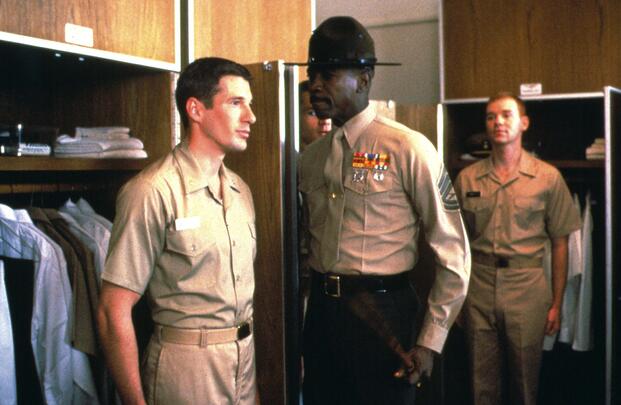
2. An Officer and a Gentleman (1982) — Aviation Officer Candidate School
The late Louis Gossett Jr. delivers the rare Oscar-winning DI turn, and instructors still respect the bearing. The film gets the physical grind — wind sprints, inspection stress, attrition — and frames leadership through pressure. As Gunnery Sgt. Emil Foley, Gossett humbles candidates on day one, warns that many won’t make it, and targets Mayo’s character as much as his fitness. The weekend “smoke session” ending with “I got nowhere else to go!” is the pivot from swagger to growth, followed by teamwork (helping Seeger over the 12-foot wall), resilience after loss, and the first-salute silver dollar — mutual respect sealed.
Realism Score: 8/10
Why It Works: Shows both sides — the hammer and the forge.
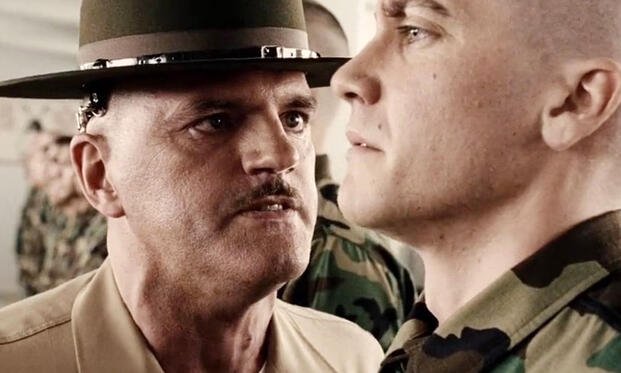
3. Jarhead (2005) — Marine Corps Training, 1990s
Adapted from Anthony Swofford’s memoir, Jarhead dodges the cliché of nonstop screaming and zeros in on repetition, boredom, and the psychological squeeze. DIs use rhythm, distance, and manipulation as tools, capturing the slow grind many Marines describe.
Former Marine Jameson Travels (YouTube) summed it up: “This is about right — the badgering, the constant questions. One note: we didn’t have DIs with facial hair… I never saw a DI wear one.” On the ever-present “Jody”: “He’s everywhere in boot camp lore… I think I broke up with my girlfriend six times in my head because of Jody.”
Realism Score: 7/10
Why It Works: Nails mental attrition more than physical pain.
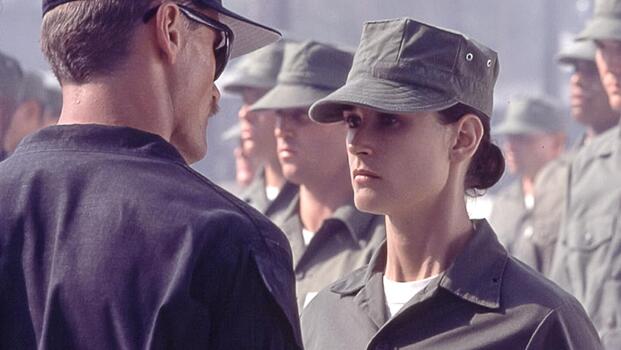
4. G.I. Jane (1997) — Navy SEAL Training
Yes, dramatized, but many instructors say Ridley Scott nails the emotional warfare of elite selection. The physical gauntlet — drown-proofing, surf torture, log PT — tracks, and the portrayal of peer pressure and team loyalty largely hold up.
Former Naval Academy grad, Surface Warfare Officer, and Navy SEAL Jake Sweig put it plainly: “G.I. Jane was a ripper. One thing it got right was the absolute chaos of SEAL training.” He calls BS on a specific fight beat (a SEAL chief passively taking a headbutt and kicks), but the larger point stands: willpower costs, and the movie shows the price.
Realism Score: 6/10
Why It Works: Less about gender politics, more about sustained willpower.
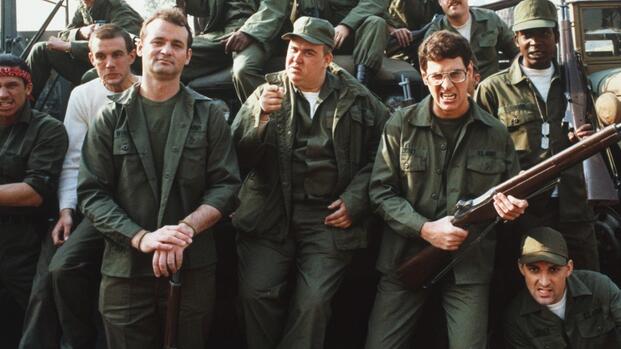
5. Stripes (1981) — Army Basic Training, Comedy Division
Marine infantryman James Laporta notes the film gets some drill basics right: march off the left foot; spacing ~40 inches; badges/ribbons measured to the inch; and drill sergeants are judged on platoon precision, not just recruits. The goofiness (guys laughing, rubber-necking) would invite instant smoke, but the skeleton of real drill is there.
When Harold Ramis launches “Do Wah Diddy Diddy,” Laporta calls foul — singing happens in the military, but cadence belongs to the drill sergeant. Bill Murray’s anti-authority bit shouldn’t work, yet the film still lands a truth: teamwork built under duress. The finale’s cadence run, parody or not, captures esprit de corps better than many dramas. The base-as-backlot chaos is artistic license — real bases are small cities — but the morale vibe is honest.
Realism Score: 3/10 for tactics, 10/10 for morale
Why It Works: We laugh to survive the grind.
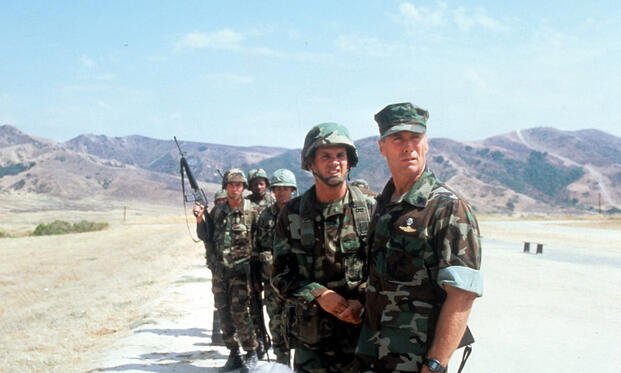
6. Heartbreak Ridge (1986) — Marine Recon Indoctrination
Moderately realistic at best. As former Army historian Gordon Rottman explains, the script started as an Army Rangers story about Grenada. The Army balked at portrayals and language, so producers pivoted to the Marines, retrofitting Clint Eastwood’s character from the Army in Korea to later transfer into the Corps (a rarity).
That swap scrambles history. On screen, Marine Force Recon executes marquee Grenada actions — rescuing students, breaking roadblocks, firefights with Cuban troops, heliocast/swim insertions. In reality, those headline missions — and the actual parachute assault — were Ranger operations. Marines landed at the far end of the island and saw limited combat. The composite approach leaves many viewers thinking Marines led and the Army trailed — largely the reverse.
Realism Score: 5/10 tactics, 2/10 history
Why It Works: Crisp leadership beats and gritty training rhythms; just don’t treat it like a documentary.
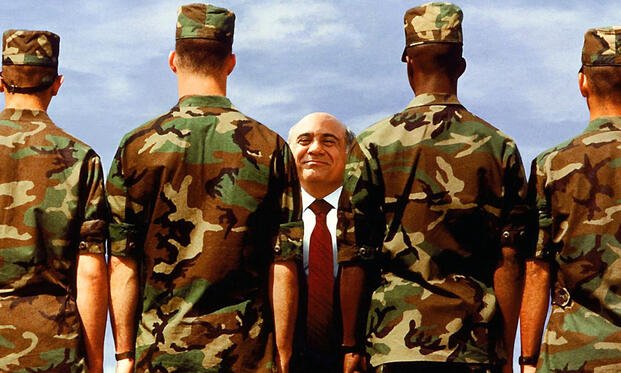
7. Renaissance Man (1994) — Army Basic at Fort McClellan
There’s no widely cited military-expert review of its boot camp accuracy, but critics and audiences landed in the same place: the military world is soft-focused. Reviews (e.g., The Baltimore Sun) called the environment unconvincing — more “cuddly 1990s armed forces” than the abrasive realism of Full Metal Jacket. Penny Marshall leans into the teacher-saves-misfits arc, so basic becomes backdrop for inspiration, not a credible grind.
Viewers with service backgrounds sometimes connect with the themes — honor, duty, growth — while acknowledging it’s about education and human connection, not procedure. Moments like an officer moved to tears by a Shakespeare recitation during a rainy drill read as crowd-pleasing, not plausible.
Realism Score: 3/10
Why It Works: Warm, transformational vibes; accuracy yields to the feel-good lesson plan.
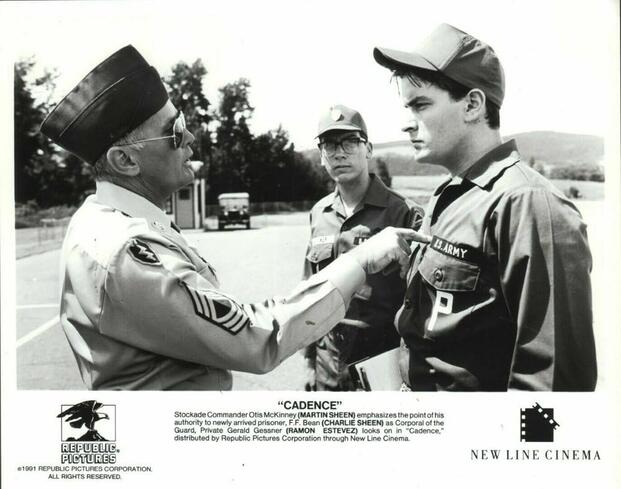
8. Cadence (1990) — Correctional Training Unit
Formal “military expert” reviews are scarce, but veterans and longtime service watchers often say the film captures Army life pretty well. Set in a mid-’60s West Germany work-camp stockade, it nails the everyday rhythm — marching, discipline, chow lines, tedious busy work — and the institutional pace that grinds people down. One viewer with a father stationed there at the time called the details “pretty accurate.”
The story throws Private Franklin Bean (Charlie Sheen), a white rebellious inmate, into an all-Black barracks under Sergeant Otis McKinney (Martin Sheen), a bigoted lifer. It leans into racial tension and eventual camaraderie, showing how men close ranks against a tyrannical authority figure — still relevant in today’s cohesion conversations. It’s also a critique of brittle authority: McKinney as a lifer who sacrificed family and perspective until the job became his identity.
Often tagged underrated, Cadence stands apart by focusing on confinement, process, and the military justice system rather than combat. Service viewers praise its authenticity in the mundane — and how bonds and frictions form inside that monotony.
Realism Score: 7/10
Why It Works: Convincing stockade routine and unit dynamics; timely themes of race, authority, and hard-won camaraderie.
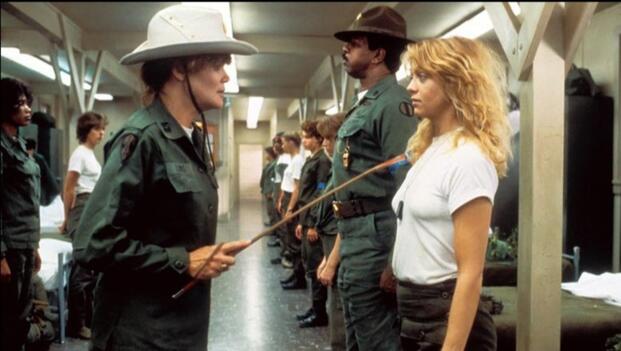
9. Private Benjamin (1980) — Army Basic Training, Women’s Corps
Released as service comedies crept back post-Vietnam, Private Benjamin updated an old Hollywood template for a “woman’s Army.” Critics (e.g., NYT archive) praised Goldie Hawn and Eileen Brennan, noting director Howard Zieff keeps classic boot-camp gags — latrine duty, war games, forced marches — nimble and crowd-pleasing. It’s funny by design, with a supporting cast (Robert Webber, Mary Kay Place, Albert Brooks, Armand Assante) built to land punchlines.
Later military-perspective assessments (including NCO Journal) argue the film hasn’t aged well in depictions of women, sexual harassment, and leadership — distracting and dated. Still, the camaraderie forged under stress rings true. Context matters: the film arrived as the all-volunteer force and women’s roles were evolving, so it’s a transitional snapshot rather than a procedural manual.
Realism Score: 4/10
Why It Works: Star-driven comedy that captures esprit de corps, even as its cultural portrayals show their age.
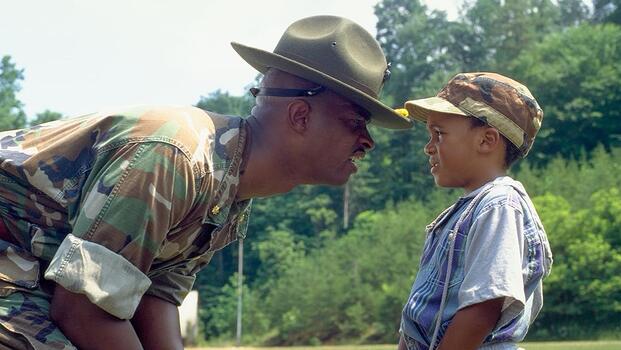
10. Major Payne (1995) — ROTC-Style Discipline, Exaggerated but Familiar
Not a “military classic,” but a crowd-pleasing family comedy with salty edges. Damon Wayans plays Maj. Benson Winifred Payne, a hard-charging Marine cut loose from active duty who lands as a JROTC instructor. The plot: whip a rambunctious cadet unit into shape and win a drill competition. Underneath the gags and quotables are usable lessons: career transitions are messy; mental toughness matters when no one’s sympathetic; improvement is incremental; don’t quit when training gets humiliating; teamwork beats talent; loyalty to your people outranks personal glory; self-confidence transforms the smallest cadet; even the toughest Marine can lighten up without losing standards.
As a depiction, it’s broad and sitcom-clean — more pep talk than procedure — but as a values package for young leaders, the beats land, and the JROTC frame fits the scaled-down tactics and pageantry.
Realism Score: 4/10 tactics, 8/10 leadership lessons
Why It Works: Uses comedy to teach discipline, resilience, teamwork, and confidence — less fieldcraft, more forging a squad.

What Real DIs Say About Hollywood Boot Camps
- “The yelling’s not random.” It’s calculated — tempo, volume, and timing serve a purpose.
- “Recruits aren’t broken. They’re re-wired.” The goal is confidence, not cruelty.
- “No movie ever nails the smell — or how sand gets everywhere.”
Transformation is the point. Cadence calls, 3 a.m. corrections, and “impossible” tasks exist to build automatic responses under stress. The best films — even comedies — get that boot camp isn’t about pain. It’s about change.
Final Formation
Great boot camp scenes don’t just show yelling — they show teaching through friction. That’s why Ermey’s voice still echoes: the sound of chaos organized into discipline, the moment you learn pressure is a teacher, not a punishment.
Story Continues
Read the full article here








